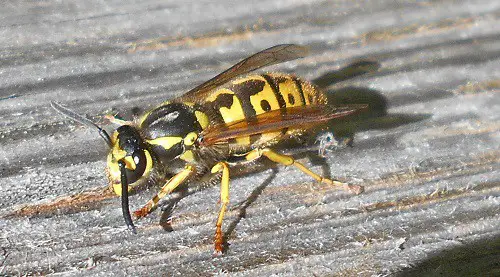- 5 Simple Tricks to Eliminate Maggots From Pet Waste - October 24, 2023
- Keep Your Outdoor Compost Piles Maggot-Free - October 24, 2023
- How to Get Rid of Maggots – Methods that Work - August 30, 2023
In the insect world, the hornet and Yellow Jacket are the most aggressive when it comes to defending their nests. Many people think the yellow jackets a bee, but compared to the bee, it has a thin waist.
When they rest, the wings folded lengthwise. However, when you disturb a colony, all hell breaks loose, and they keep stinging.
The problem is that having them in your garden is not such a dilemma, but it can become one when you have a picnic or eating outdoors as they are attracted to what you eat.
Do you have a yellow jacket settlement in your garden? Are you wondering how to get rid of yellow jackets? You have arrived at the right place as we can help.
What attracts Yellow Jackets?
In the USA, you can find several species of this wasp with its yellow color looking as if it is wearing a jacket. You find them in northern temperature climates. However, you can also find the wasp with yellow jackets in the Western and Southern parts of the United States as well.
Sometimes you can find the wasp in other parts of the world as well but mostly in the USA. The colony remains active throughout summer, and the queen then leaves the nest to start a new nest of yellow jackets.
The wasps that remain die at the end of the season. The nest remains unused, except the German yellowjackets. The yellow jacket is social wasps that are part of the Vespula species.
Yellow Jackets Nest Building
In one season, a colony comprises thousands of workers, and the insect can make a nest in different structures. The German yellowjacket makes its nests in walls, cracks, crevices, wall voids, and crawlspaces of buildings.
The problem is that this specie is a significant threat to the beekeeping industry as they can destroy a colony of bees quickly. So if you are in the beekeeping trade these insects do not have rights reserved and best to get rid of fast.
The wasp uses paper from wood and saliva to build their nest and will reuse the nest year after year. Then you have other wasp species that make their nest in structures and the ground. The common yellowjacket can construct a nest above and below the ground.

Yellow Jackets Eating Habits
While the Western and Eastern yellow jacket makes their nest in the ground, some people call them the meat bees as they use rodent’s tunnels to build their nest and also enjoy feeding on meat from bees or the meat you eat.
To see this wasps nest, you need to look for small stones or any dirt particles piled up around the burrow openings. Now, some of these insects do build aerial nests that hang from trees or at the eaves of buildings. These types of yellow jackets are not that aggressive as the ones you find building nests in structures.
The yellow jacket also preys on different insects and arthropods. Furthermore, they will forage for food left behind by people as well. The yellow jackets love sweets and meats and considered a beneficial insect as it eats other insects.
While they are useful, they can become a nuisance when aggressive and leave burning stings. Therefore, it is crucial to wear protective clothing when you do plan on taking care of the nests.
What is the Best Way to Get Rid Of Yellow Jacket?
During summer and you plan on mowing the lawn or use a brush cutter, it is best to inspect the yard for the insect wearing a yellowish jacket. While the sting is temporary and painful, some people do have an allergic reaction to a bite.
The problem is that when you disturb a colony, you have more than one of these insects attacking you. The big question when should I spray my yellow jacket nests?
The best time to do this is to locate the nest during the day and start treating it at night. The reason is that all wasps are active during the day and not at night.
Moreover, no matter what you do wear protective clothing to tackle aerial nests to ground structures.
Control Measures to Take
First, you need to start sanitizing the area where you found the yellow jacket nest by removing possible food to reduce foraging during the late summer to mid-autumn.
Keep garbage containers closed and make sure to empty open containers regularly. To kill the nest, you need to locate it first during the day to see where the entry and existing points are. You may find multiple entry points and best to make sure.
For treating, the nest instead does it at night when it is dark. The main reason is that the wasp cannot see well, and the chance of getting stung reduces. Not only will it prevent you from hurt, but the whole colony will be present as well.
There are different products available to treat the insect with its yellow body covered with a jacket :
- Stryker 54 Contact Aerosol
- PT 565
- CV-80D
These products all have a gas form known as pyrethrum that fills up the cavity of the nest, killing all of them on contact. Once you have done this, you need to wait for the substance to dry and dust the opening with some Tempo Dust.
What the insecticide does is prevent further hatch outs. Use the dust on the entranceways and the surrounding areas. Leave the nest overnight and check it in the morning to see if all the yellow jackets are dead and repeat if needed.
You can also use D Fense or Evergreen Dust as well, that is a botanical insecticide. However, if you have a hard time getting into small places, use a Gotcha Sprayer Pro Adaptor that fits on an extension pole.
Furthermore, we recommend that if you are not able to handle the yellow jackets infestation yourself call a pest control expert to take care of the problem.
For the Best Results to Remove Yellow Jackets
Another exceptional insecticide for removing any type of yellow jackets is Walt’s Yellow Jacket Kit made up of Tempo Dust and Stryker 54. Here we also recommend taking care of the yellow jackets nests in late summer.
Alternatively, you can use yellow jacket bait stations and get the Alpine Yellow Jacket Bait Station with Onslaught Insecticide. You place the station with fresh meat and the insecticide, and it lures the yellow jacket to the bait. Once they ingest the meat mixture, it kills the insect.
You can use the bait station during spring to summer for common yellow jacket infestations. However, during the fall months, the insect prefers eating carbohydrates instead. If you are not able to locate the yellow-jacket nest, then a trap works better. Doing this has loads of advantages as follow:
- Place the trap away from the house, as you want to lure them in that direction.
- You can use it during cookouts and picnics as it lures the insect away from you.
- The traps work well with meat in warm months while fruit juice works best in late summer to fall.
With Care and Caution, You Can Remove a Yellow Jacket
When it comes to removing yellow jackets from your yard, the best is at night. Always hang traps or a bait station away from the home to prevent injury to animals and kids.
However, during winter months, the yellow jacket can move into cracks in walls to survive the winter. You will only see them coming out in spring and called reproductive yellow-jackets that rarely sting.
Furthermore, if the nest of the yellow jackets in a sunny location, they can survive.
Always remember to locate the wasp’s nest during the day to see where they enter, exist, and mark these points to treat at night.
However, if you are concerned about removing the insect with its yellowish jacket yourself call in a pest control expert that knows what they are doing.
Sources:
http://entnemdept.ufl.edu/creatures/urban/occas/hornet_yellowjacket.htm
